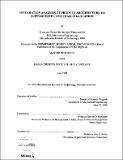| dc.contributor.advisor | Steven D. Eppinger. | en_US |
| dc.contributor.author | Gutierrez, Carlos Iñaki | en_US |
| dc.date.accessioned | 2005-08-19T18:50:08Z | |
| dc.date.available | 2005-08-19T18:50:08Z | |
| dc.date.copyright | 1998 | en_US |
| dc.date.issued | 1998 | en_US |
| dc.identifier.uri | http://hdl.handle.net/1721.1/9600 | |
| dc.description | Thesis (S.M.)--Massachusetts Institute of Technology, Dept. of Mechanical Engineering, 1998. | en_US |
| dc.description | Includes bibliographical references (leaves 88-90). | en_US |
| dc.description.abstract | Successful product development efforts are greatly facilitated through the use of integration analysis. Teams working on a product development project need to be brought together into clusters to address interactions between the functions or product elements they represent. This thesis presents a stochastic clustering algorithm to find such clusters in an efficient manner. The algorithm can find clustering solutions to architecture and organization interaction problems modeled using the design structure matrix method. The algorithm can be controlled to favor solutions with certain characteristics such as level of overlap, number of clusters, maximum number of teams per cluster, and emphasis on the level of interactions addressed by the clusters. The difficulty to co-locate teams is measured by a coordination cost, which varies according to the composition of clusters. A mathematical model that minimizes the coordination cost to find the optimal solution for a given number of clusters has been developed. It has been used to measure the performance of the algorithm through a series of comparison tests. When the algorithm is run several times, the best solutions are reasonably close to an optimal solution. As a sample application, the algorithm is used to analyze the architecture of an automotive cockpit system according to six dimensions of integration. A set of solutions with different number of clusters was generated. | en_US |
| dc.description.statementofresponsibility | by Carlos Iñaki Gutierrez Fernandez. | en_US |
| dc.format.extent | 120 leaves | en_US |
| dc.format.extent | 9552191 bytes | |
| dc.format.extent | 9551951 bytes | |
| dc.format.mimetype | application/pdf | |
| dc.format.mimetype | application/pdf | |
| dc.language.iso | eng | en_US |
| dc.publisher | Massachusetts Institute of Technology | en_US |
| dc.rights | M.I.T. theses are protected by copyright. They may be viewed from this source for any purpose, but reproduction or distribution in any format is prohibited without written permission. See provided URL for inquiries about permission. | en_US |
| dc.rights.uri | http://dspace.mit.edu/handle/1721.1/7582 | |
| dc.subject | Mechanical Engineering | en_US |
| dc.title | Integration analysis of product architecture to support effective team co-location | en_US |
| dc.type | Thesis | en_US |
| dc.description.degree | S.M. | en_US |
| dc.contributor.department | Massachusetts Institute of Technology. Department of Mechanical Engineering | en_US |
| dc.identifier.oclc | 42202655 | en_US |
